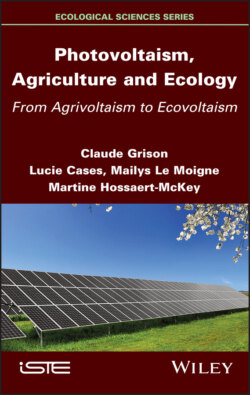Photovoltaism, Agriculture and Ecology

Реклама. ООО «ЛитРес», ИНН: 7719571260.
Оглавление
Martine Hossaert-McKey. Photovoltaism, Agriculture and Ecology
Table of Contents
List of Illustrations
List of Tables
Guide
Pages
Photovoltaism, Agriculture and Ecology. From Agrivoltaism to Ecovoltaism
Foreword by Yvon Le Maho
Foreword by Thomas Lesueur
Introduction
How can we combine energy and ecological transition?
1. Photovoltaics: Concepts and Challenges. 1.1. Brief description of the different photovoltaic cell technologies
1.1.1. Photovoltaic versus thermal solar panels
1.2. Different types of photovoltaic installations
1.3. Legislation
1.4. Advantages of photovoltaics
1.5. Disadvantages of photovoltaics
1.6. Some figures on the environmental footprint compared to other energy sources
1.7. Origin of the silicon needed for the construction of photovoltaic cells
1.8. End of life of solar panels
1.9. Degree of maturity of material recycling
1.10. Location and mode of development of photovoltaics. 1.10.1. Photovoltaic panels on roofs
1.10.1.1. In the industry
Box 1.1.Examples (ADEME 2018b, 2018c)
1.10.1.2. In agriculture
1.10.1.3. Public spaces
1.10.1.4. Individuals
1.10.2. Ground-mounted photovoltaic panels: creating solar fields on unused industrial wastelands and parking lots
1.10.2.1. Legislation and characteristics
1.10.2.1.1. The need for facilities to be consistent with the local urban planning document
1.10.2.1.2. A mandatory individual authorization to build a ground-mounted photovoltaic power plant
1.10.2.1.3. Issues
1.10.3. Creating solar fields in arid areas
1.10.4. Creating photovoltaic parks on water
2. Photovoltaic Energy Production and Agricultural Activity: Agrivoltaics
2.1. Definition–legislation–adaptation and evolution of techniques
Static, ground-mounted solar panels
Dynamic solar panels, on the ground
Cultivation in photovoltaic greenhouses
2.2. Food crops
2.2.1. Fish farming
2.2.2. Oyster farming
2.2.3. Viticulture
2.2.4. Arboriculture and fruit production
2.2.5. Field crops
2.2.6. Market gardening: shades, greenhouses, protective structures for environmental conditions
2.2.7. Other crops. 2.2.7.1. Crops for non-food use. 2.2.7.1.1. Production of essential oils
2.2.7.1.2. Horticulture
2.2.7.2. Mushroom cultures
2.2.8. Pasture and livestock
3. Innovative Principle of Ecovoltaics. 3.1. Definition and concept
3.2. State of the art: feedback
3.2.1. Constraints of the experimental site in Occitanie
3.2.2. Planting of species of interest in biodynamic agriculture on the grounds of solar parks
3.2.2.1. The eagle fern, Pteridium aquilinum. 3.2.2.1.1. Botanical characteristics
What is the geographical distribution?
Development under solar panels: an opportunity?
3.2.2.1.2. Use in biodynamic agriculture
3.2.2.2. Alder buckthorn, Frangula alnus. 3.2.2.2.1. Botanical characteristics
3.2.2.2.2. Use in biodynamic agriculture
3.2.2.3. Comfrey, Symphytum peregrinum. 3.2.2.3.1. Botanical characteristics
3.2.2.3.2. Use in biodynamic agriculture
3.2.2.4. Rhubarb, Rheum rhabarbarum. 3.2.2.4.1. Botanical characteristics
3.2.2.4.2. Use in biodynamic agriculture
3.2.2.4.3. Other interests of rhubarb
3.2.2.5. Borage, Borrago officinalis. 3.2.2.5.1. Botanical characteristics
3.2.2.5.2 Use in biodynamic agriculture
3.2.3. Planting of melliferous species
3.2.4. Installation of regionally endangered species
3.2.5. Installation of medicinal species
3.3. Assessment – issues
3.3.1. Positive impact on soil quality
3.3.2. Positive impact on faunal biodiversity
3.4. Perspectives
3.4.1. Regulations for the marketing of plants or plant extracts for use in biodynamic agriculture
Appendix 1. Secondary Metabolites and Defense Molecules of Eagle Fern. A1.1. Prunasin
A1.2. Ptaquiloside (also called aquilide A)
A1.3. Thiaminase I (antithiamine)
A1.4. Other metabolites
Appendix 2. Secondary Metabolites and Defense Molecules of Alder Buckthorn
Appendix 3. Secondary Metabolites and Defense Molecules of Rhubarb. A3.1. Carboxylic acids
A3.2. Minerals
A3.3. Anthraquinones
A3.4. Stilbenes
A3.5. Flavonoids
References
Index. A, B
C, D
E, F
G, H
I, L
M, N, O
P, R
S, T, V
WILEY END USER LICENSE AGREEMENT
Отрывок из книги
Series EditorFrançoise Gaill
.....
This agreement was adopted at the Paris Climate Conference (COP21) in December 2015 (Commission européenne 2016). This was a historic event, as it represents the first global agreement on climate change. It was signed by 195 countries, including the European Union. As Laurent Fabius said, this is not a political agreement, but an agreement for the climate. It requires everyone to take responsibility.
The green pact or green deal for Europe proposes a roadmap that should lead to carbon neutrality in 2050 (Commission européenne 2019).
.....